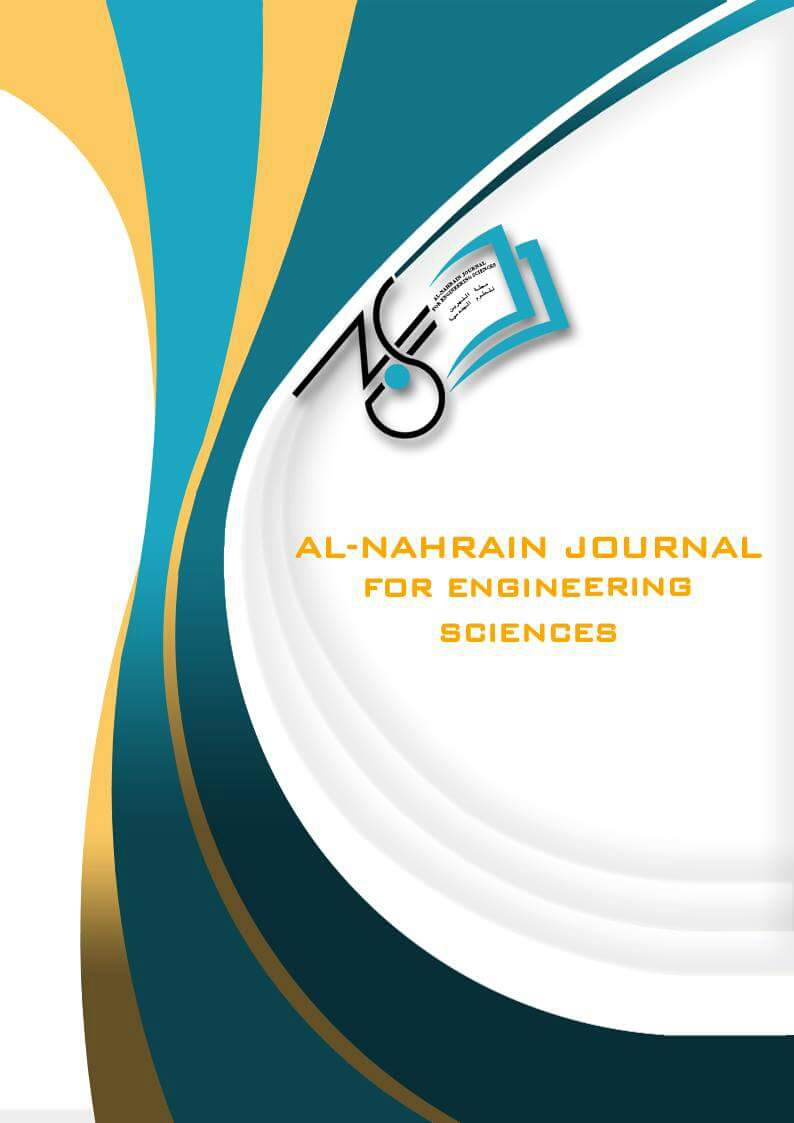Behavior of Reinforced Zero Cement Concrete Slabs under Monotonic Load
DOI:
https://doi.org/10.29194/NJES.27030328Keywords:
Zero Cement Concrete, Carbon Emission, Molarity, Cement IndustryAbstract
Searching for an optimal alternative to normal cement concrete (NCC) is an urgent need nowadays in order to reduce carbon dioxide emissions, reduce energy, and reduce waste materials. Therefore, this research aims to examine zero cement concrete (ZCC) slabs under monotonic loads with several paramedic studies including slab thickness (60mm, 80mm, 100 mm), bar spacing (75mm, 150mm, and 225mm), and molarity concentration (6M, 8M, and 10M). The results showed the behavior of reinforced ZCC slabs is similar to or slightly lower than that of normal cement concrete. Increasing slab thickness from 60 mm to 80 mm and 100 mm enhanced the slab stiffness, increased the applied loads, and reduced the vertical mid-span deflection. Decreasing bar spacing by 33.33% and 66.67% relative to 225 mm reduced also the deflection. The energy absorption was increased due to increasing the slab thickness and bar spacing. When the load increased, the slabs eventually failed by a typically visible punching cone (punching shear).
Downloads
References
V. S. Athira, V. Charitha, G. Athira, and A. Bahurudeen, “Agro-waste ash based alkali-activated binder: Cleaner production of zero cement concrete for construction,” J. Clean. Prod., vol. 286, p. 125429, 2021, doi: 10.1016/j.jclepro.2020.125429. DOI: https://doi.org/10.1016/j.jclepro.2020.125429
J. Davidovits, “High-Alkali Cements for 21st Century Concretes,” ACI Symp. Publ., vol. 144, no. Special Publication, pp. 383–398, 1994, doi: 10.14359/4523. DOI: https://doi.org/10.14359/4523
V. Masson-Delmotte et al., “Global warming of 1.5 C̊,” An IPCC Spec. Rep. impacts Glob. Warm., vol. 1, no. 5, p. 36, 2018, [Online]. Available: https://www.ipcc.ch/sr15/
T. Bakharev, J. G. Sanjayan, and Y.-B. Cheng, “Sulfate attack on alkali-activated slag concrete,” Cem. Concr. Res., vol. 32, no. 2, pp. 211–216, 2002, doi: https://doi.org/10.1016/S0008-8846(01)00659-7. DOI: https://doi.org/10.1016/S0008-8846(01)00659-7
E. Gomaa, S. Sargon, C. Kashosi, and M. ElGawady, “Characterization and Performance of Zero-Cement Concrete,” United States, Missouri, 2018. [Online]. Available: https://rosap.ntl.bts.gov/view/dot/37913
R. J. Thomas and S. Peethamparan, “Alkali-activated concrete: Engineering properties and stress–strain behavior,” Constr. Build. Mater., vol. 93, pp. 49–56, 2015, doi: https://doi.org/10.1016/j.conbuildmat.2015.04.039. DOI: https://doi.org/10.1016/j.conbuildmat.2015.04.039
A. Bisarya, R. K. Chouhan, M. Mudgal, and S. S. Amritphale, “Fly ash based geopolymer concrete a new technology towards the greener environment: A review,” Int. J. Innov. Res. Sci. Eng. Technol, vol. 4, no. 12, pp. 12178–12186, 2015, doi: 10.15680/IJIRSET.2015.0412089.
M. I. A. Aleem and P. D. Arumairaj, “Optimum mix for the geopolymer concrete,” Indian J. Sci. Technol., vol. 5, no. 3, pp. 2299–2301, 2012, doi: 10.17485/ijst/2012/v5i3.8. DOI: https://doi.org/10.17485/ijst/2012/v5i3.8
M. I. A. Aleem and P. D. Arumairaj, “Geopolymer concrete–a review,” Int. J. Eng. Sci. Emerg. Technol., vol. 1, no. 2, pp. 118–122, 2012, doi: 10.7323/ijeset/v1_i2_14. DOI: https://doi.org/10.7323/ijeset/v1_i2_14
M. Wasim, A. Abadel, B. H. Abu Bakar, and I. M. H. Alshaikh, “Future directions for the application of zero carbon concrete in civil engineering – A review,” Case Stud. Constr. Mater., vol. 17, p. e01318, 2022, doi: 10.1016/j.cscm.2022.e01318. DOI: https://doi.org/10.1016/j.cscm.2022.e01318
V. K. J. Bohra, R. Nerella, and S. R. C. Madduru, “Material properties, processing & characterization of fly ash based geopolymer,” Mater. Today Proc., vol. 19, pp. 2617–2621, 2019, doi: 10.1016/j.matpr.2019.10.099. DOI: https://doi.org/10.1016/j.matpr.2019.10.099
S. S. Arun Kumar, A. Madhavan, and S. Dharmar, “Experimental Srudy on Impact Resistance of Geopolymer Ferrocement Flat Panel,” SSRG Int. J. Civ. Eng., no. Special Issue ICRTCETM-Part 4, pp. 278–282, 2017, [Online]. Available: https://www.internationaljournalssrg.org/special_issues/specialissues_paperlist/5-Part4-8
M. Rajendran and N. Soundarapandian, “An experimental investigation on the flexural behavior of geopolymer ferrocement slabs,” J. Eng. Technol., vol. 3, p. 97, Aug. 2013, [Online]. Available: https://link.gale.com/apps/doc/A349640871/AONE?u=anon~1a1532df&sid=googleScholar&xid=7e50d4e6 DOI: https://doi.org/10.4103/0976-8580.113047
D. Sakkarai and N. Soundarapandian, “Strength Behavior of Flat and Folded Fly Ash-Based Geopolymer Ferrocement Panels under Flexure and Impact,” Adv. Civ. Eng., vol. 2021, p. 2311518, 2021, doi: 10.1155/2021/2311518. DOI: https://doi.org/10.1155/2021/2311518
S. S. Hiremath, “FLEXURAL BEHAVIOUR OF GEOPOLYMER BASED FERROCEMENT PANELS,” Int. J. Appl. Eng. Res., vol. 13, no. 7, pp. 284–291, 2018.
M. Ramalingam, P. Mohan, P. Kathirvel, and G. Murali, “Flexural Performance and Microstructural Studies of Trough-Shaped Geopolymer Ferrocement Panels,” Materials, vol. 15, no. 16. p. 5477;, 2022. doi: 10.3390/ma15165477. DOI: https://doi.org/10.3390/ma15165477
M. Rajendran and N. Soundarapandian, “Geopolymer ferrocement panels under flexural loading,” J. Sci. Eng. Compos. Mater., vol. 22, no. 3, pp. 331–341, 2013, doi: 10.1515/secm-2013-0012. DOI: https://doi.org/10.1515/secm-2013-0012
N. Li, C. Shi, Z. Zhang, H. Wang, and Y. Liu, “A review on mixture design methods for geopolymer concrete,” Compos. Part B Eng., vol. 178, p. 107490, 2019, doi: https://doi.org/10.1016/j.compositesb.2019.107490. DOI: https://doi.org/10.1016/j.compositesb.2019.107490
ASTM-C618, “Standard specification for coal fly ash and raw or calcined natural pozzolan for use in concrete,” in Annual Book of ASTM Standards, West Conshohocken, PA, USA: ASTM American Society for Testing and Materials:, 2017, p. 5. doi: 10.1520/C0618-17. DOI: https://doi.org/10.1520/C0618-17
ASTM-C-494C/494M, “Standard Specification for Chemical Admixtures for Concrete,” in Annual Book of ASTM Standards Volume: 04.02, American Society for Testing and Materials, 2019, p. 10. doi: 10.1520/C0494_C0494M-17. DOI: https://doi.org/10.1520/C0494_C0494M-17
BS-EN/934-2, “Admixtures for Concrete, Mortar and Grouting, Part 2: Concrete admixtures — Definitions, requirements, conformity, marking and labelling.” British Standard Institution, London, p. 28, 2001.
ACI-318M, “Building Code Requirements for Structural Concrete,” in American Concrete Institute Standards, Southern California: American Concrete Institute, 2019.
Downloads
Published
Issue
Section
License
Copyright (c) 2024 Maher Mahmoud Hassoon, Musab Aied Qissab

This work is licensed under a Creative Commons Attribution-NonCommercial 4.0 International License.
The authors retain the copyright of their manuscript by submitting the work to this journal, and all open access articles are distributed under the terms of the Creative Commons Attribution-NonCommercial 4.0 International (CC-BY-NC 4.0), which permits use for any non-commercial purpose, distribution, and reproduction in any medium, provided that the original work is properly cited.














